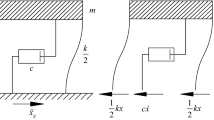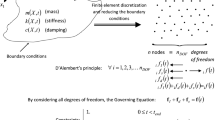Abstract
We present a new seismic intensity measure (IM) to reduce the dispersion in incremental dynamic analysis (IDA), which commonly use the elastic spectral acceleration as the IM. We propose using the inelastic spectral acceleration based on the principles of modal pushover analysis (MPA) as the seismic IM of ground motion. Unlike other methods of computing inelastic spectral acceleration, this new metric is calculated from the result of equivalent single degree-of-freedom (SDF) systems under the lateral force mode using the uncoupled modal response history analysis procedure. These equivalent SDF systems consider the constantly changing elastic–plastic hysteretic behaviour of the structure itself with different seismic intensities. The results indicate that the improved IDA method can more accurately estimate nonlinear structural responses in many intensity levels covering the entire range of structural responses—all the way from elastic behaviour to global dynamic instability. When the structure enters into the inelastic range, the seismic performance of the IDA’s dispersion using the inelastic spectral acceleration as the seismic IM is better than that using peak ground acceleration or elastic spectral acceleration.










Similar content being viewed by others
References
Vamvatsikos D, Cornell CA (2002) Incremental dynamic analysis. Earthq Eng Struct Dyn 31(3):491–514
Vamvatsikos D, Fragiadakis M (2010) Incremental dynamic analysis for estimating seismic performance sensitivity and uncertainty. Earthq Eng Struct Dyn 39(2):141–163
Bradley BA, Dhakal RP, MacRae GA, Cubrinovski M (2010) Prediction of spatially distributed seismic demands in specific structures: ground motion and structural response. Earthq Eng Struct Dyn 39(5):501–520
Bertero VV (1977) Strength and deformation capacities of buildings under extreme environments. In: Pister KS (ed) Structural engineering and structural mechanics. Prentice Hall, Englewood Cliffs, pp 211–215
Giovenale P, Cornell CA, Esteva L (2004) Comparing the adequacy of alternative ground motion intensity measures for the estimation of structural responses. Earthq Eng Struct Dyn 33(8):951–979
Vamvatsikos D, Cornell CA (2005) Developing efficient scalar and vector intensity measures for IDA capacity estimation by incorporating elastic spectral shape information. Earthq Eng Struct Dyn 34(13):1573–1600
Vamvatsikos D, Fragiadakis M (2009) Incremental dynamic analysis for estimating seismic performance sensitivity and uncertainty. Earthq Eng Struct Dyn 39(2):141–163
Luco N, Cornell CA (2007) Structure-specific scalar intensity measures for near–source and ordinary earthquake ground motions. Earthq Spectra 23(2):357–392
Tothong P, Luco N (2007) Probabilistic seismic demand analysis using advanced ground motion intensity measures. Earthq Eng Struct Dyn 36(13):1837–1860
Mollaioli F, Lucchini A, Cheng Y, Monti G (2013) Intensity measures for the seismic response prediction of base-isolated buildings. Bull Earthq Eng 11(5):1841–1866
Douglas J, Seyedi DM, Ulrich T et al (2015) Evaluation of seismic hazard for the assessment of historical elements at risk: description of input and selection of intensity measures. Bull Earthq Eng 13(1):49–65
Ebrahimian H, Jalayer F, Lucchini A et al (2015) Preliminary ranking of alternative scalar and vector intensity measures of ground shaking. Bull Earthq Eng 13(10):2805–2840
Luco N, Bazzurro P (2007) Does amplitude scaling of ground motion records result in biased nonlinear structural drift responses? Earthq Eng Struct Dyn 36(13):1813–1835
Chopra AK, Goel RK (2002) A modal pushover analysis procedure for estimating seismic demands for buildings. Earthq Eng Struct Dyn 31(3):561–582
Han SW, Chopra AK (2006) Approximate incremental dynamic analysis using the modal pushover analysis procedure. Earthq Eng Struct Dyn 35(15):1853–1873
Kalkan E, Chopra AK (2010) Modal-pushover-based ground–motion scaling procedure. J Struct Eng 37(3):298–310
Moon KH, Han SW, Lee TS et al (2012) Approximate MPA-based method for performing incremental dynamic analysis. Nonlinear Dyn 67(4):2865–2888
Chopra AK (2007) Dynamics of structures-theory and applications to earthquake engineering, 3rd edn. Prentice Hall, New Jersey
GB50011-2010 (2010) Code for seismic design of buildings. China Architecture & Building Press, Beijing
IDARC 2D Version 6.1 (2006) Software for inelastic damage analysis of R/C buildings (IDARC). State University of New York, Buffalo
Pacific Earthquake Engineering Research Center (PEER) (2013) PEER ground motion database (NGA-West2). http://ngawest2.berkeley.edu. Accessed 15 Jan 2016
Power MS, Youngs RR, Chin C (2004) Design ground motion library. In: Paper presented at the Report of PEER-LL Program Task 1F01
Shome N, Cornell CA (1999) Probabilistic seismic demand analysis of nonlinear structures. Report No. RMS-35, RMS Program, Stanford University, Stanford, CA
Davoodi M, Sadjadi M (2015) Assessment of near-field and far-field strong ground motion effects on soil-structure SDOF system. Int J Civil Eng 13(3 and 4B):153–166
Baker JW, Cornell CA (2006) Vector-valued ground motion intensity measures for probabilistic seismic demand analysis. Pacific Earthquake Engineering Research Center, College of Engineering, University of California, Berkeley
Acknowledgments
Financial support of this study was fully provided by the National Key Technology R&D Program (2015BAK18B01), National Science Foundation of China (51508527, 51378477), and National Non-profit Institute Research Grant of IGP-CEA (DQJB14C01, DQJB15C05).
Author information
Authors and Affiliations
Corresponding author
Rights and permissions
About this article
Cite this article
Chen, B., Wen, Z. & Wang, F. An Improved Seismic Intensity Measure of Inelastic Spectral Acceleration Based on MPA to Reduce the Dispersion in IDA. Int J Civ Eng 16, 57–65 (2018). https://doi.org/10.1007/s40999-016-0063-9
Received:
Revised:
Accepted:
Published:
Issue Date:
DOI: https://doi.org/10.1007/s40999-016-0063-9




